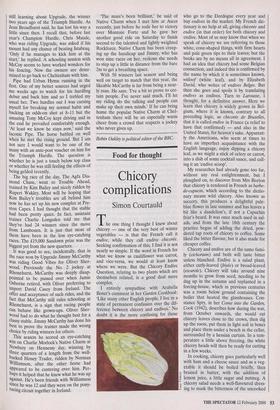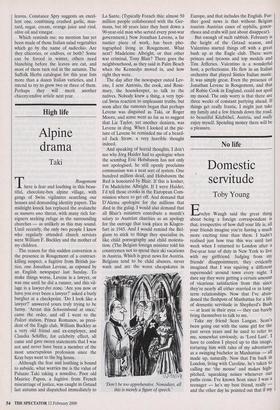Food for thought
Chicory complications
Simon Courtauld
The one thing I thought I knew about chicory — one of the very best of winter vegetables — is that the French call it endive, while they call endive chicoree. Seeking confirmation of this, I find it is not nearly so simple. If the word in French for what we know as cauliflower was carrot, and vice-versa, we would at least know where we were. But the Chicory Endive Question, relating to two plants which are themselves related, is a good deal more complex. I entirely sympathise with Arabella Boxer's comment in her Garden Cookbook: `Like many other English people, I live in a state of permanent confusion over the dif- ference between chicory and endives.' No doubt it is the more confusing for those who go to the Dordogne every year and buy endives in the market. My French dic- tionary is no help at all, giving chicoree and endive (in that order) for both chicory and endive. Most of us may know that when we speak of chicory we are referring to those white, cone-shaped things, with firm hearts and pale green tips to their leaves; but the books are by no means all in agreement. I had an idea that chicory had some Belgian connection, and indeed this is confirmed by the name by which it is sometimes known, witloof (white leaf), and by Elizabeth David, who writes of endives Beiges. But then she goes and spoils it by translating endives as endives. Turn to Larousse, I thought, for a definitive answer. Here we learn that chicory is widely grown in Bel- gium, where it is known, contrary to all preceding logic, as chicoree de Bruxelles, that it is called endive in France (a relief to have that confirmed) — and also in the United States, for heaven's sake. Apparent- ly the Americans, who seem at times to have an imperfect acquaintance with the English language, enjoy dipping a chicory leaf, as we might a stick of celery or carrot, into a dish of some cocktail sauce, and call- ing it an 'endive scoop'.
My researches had already gone too far, without any real enlightenment, but I ploughed on, to discover from Mrs Beeton that chicory is rendered in French as barbe- de-capucin, which according to the dictio- nary means wild chicory. Also known as succory, this produces a delightful pale- blue flower in late summer and has leaves a bit like a dandelion's, if not a Capuchin friar's beard. It was once much used in sal- ads, and from the late 18th century the practice began of adding the dried, pow- dered tap roots of chicory to coffee. Some liked the bitter flavour, but it also made for cheaper coffee.
Chicory and endive are of the same fami- ly (cichorium) and both will taste bitter unless blanched. Endive is a salad plant, either curly-leaved (frisee) or broad-leaved (escarole). Chicory will take around nine months to grow from seed, needing to be dug up in the autumn and replanted in a forcing-house, which in previous centuries was a room below ground containing the boiler that heated the glasshouses. Con- stance Spry, in her Come into the Garden, Cook (1942), describes how during the war, from October onwards, she would cut chicory leaves close to the crown, then dig up the roots, put them in light soil in boxes and place them under a bench in the cellar, surrounded by a hessian curtain. In a tem- perature a little above freezing, the white chicory heads will then be ready for cutting in a few weeks.
In cooking, chicory goes particularly well with ham and a cheese sauce and as a veg- etable it should be boiled briefly, then braised in butter, with the addition of lemon juice, a little sugar and nutmeg. A chicory salad needs a well-flavoured dress- -9 ing to mask the bitterness of the uncooked leaves. Constance Spry suggests an excel- lent one, combining crushed garlic, mus- tard, sugar, cream, orange juice and rind, olive oil and vinegar.
Which reminds me: no mention has yet been made of those Italian salad vegetables which go by the name of radicchio. Are they chicories, or endives, or both? Some can be forced in winter, others need blanching before the leaves are cut, and most of them turn red in the autumn. The Suffolk Herbs catalogue for this year lists more than a dozen Italian varieties, and I intend to try to grow two or three of them. Perhaps they will merit another chicory/endive article next year.



































































 Previous page
Previous page